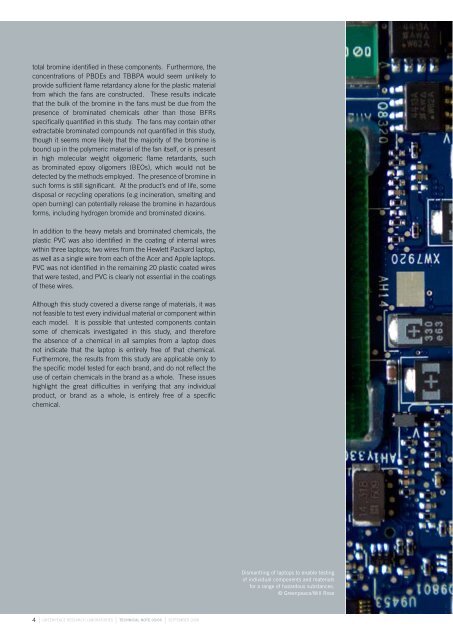toxic chemicals in computers exposed - What, why and who are the ...
toxic chemicals in computers exposed - What, why and who are the ...
toxic chemicals in computers exposed - What, why and who are the ...
Create successful ePaper yourself
Turn your PDF publications into a flip-book with our unique Google optimized e-Paper software.
total brom<strong>in</strong>e identified <strong>in</strong> <strong>the</strong>se components. Fur<strong>the</strong>rmore, <strong>the</strong><br />
concentrations of PBDEs <strong>and</strong> TBBPA would seem unlikely to<br />
provide sufficient flame retardancy alone for <strong>the</strong> plastic material<br />
from which <strong>the</strong> fans <strong>are</strong> constructed. These results <strong>in</strong>dicate<br />
that <strong>the</strong> bulk of <strong>the</strong> brom<strong>in</strong>e <strong>in</strong> <strong>the</strong> fans must be due from <strong>the</strong><br />
presence of brom<strong>in</strong>ated <strong>chemicals</strong> o<strong>the</strong>r than those BFRs<br />
specifically quantified <strong>in</strong> this study. The fans may conta<strong>in</strong> o<strong>the</strong>r<br />
extractable brom<strong>in</strong>ated compounds not quantified <strong>in</strong> this study,<br />
though it seems more likely that <strong>the</strong> majority of <strong>the</strong> brom<strong>in</strong>e is<br />
bound up <strong>in</strong> <strong>the</strong> polymeric material of <strong>the</strong> fan itself, or is present<br />
<strong>in</strong> high molecular weight oligomeric flame retardants, such<br />
as brom<strong>in</strong>ated epoxy oligomers (BEOs), which would not be<br />
detected by <strong>the</strong> methods employed. The presence of brom<strong>in</strong>e <strong>in</strong><br />
such forms is still significant. At <strong>the</strong> product’s end of life, some<br />
disposal or recycl<strong>in</strong>g operations (e.g <strong>in</strong>c<strong>in</strong>eration, smelt<strong>in</strong>g <strong>and</strong><br />
open burn<strong>in</strong>g) can potentially release <strong>the</strong> brom<strong>in</strong>e <strong>in</strong> hazardous<br />
forms, <strong>in</strong>clud<strong>in</strong>g hydrogen bromide <strong>and</strong> brom<strong>in</strong>ated diox<strong>in</strong>s.<br />
In addition to <strong>the</strong> heavy metals <strong>and</strong> brom<strong>in</strong>ated <strong>chemicals</strong>, <strong>the</strong><br />
plastic PVC was also identified <strong>in</strong> <strong>the</strong> coat<strong>in</strong>g of <strong>in</strong>ternal wires<br />
with<strong>in</strong> three laptops; two wires from <strong>the</strong> Hewlett Packard laptop,<br />
as well as a s<strong>in</strong>gle wire from each of <strong>the</strong> Acer <strong>and</strong> Apple laptops.<br />
PVC was not identified <strong>in</strong> <strong>the</strong> rema<strong>in</strong><strong>in</strong>g 20 plastic coated wires<br />
that were tested, <strong>and</strong> PVC is clearly not essential <strong>in</strong> <strong>the</strong> coat<strong>in</strong>gs<br />
of <strong>the</strong>se wires.<br />
Although this study covered a diverse range of materials, it was<br />
not feasible to test every <strong>in</strong>dividual material or component with<strong>in</strong><br />
each model. It is possible that untested components conta<strong>in</strong><br />
some of <strong>chemicals</strong> <strong>in</strong>vestigated <strong>in</strong> this study, <strong>and</strong> <strong>the</strong>refore<br />
<strong>the</strong> absence of a chemical <strong>in</strong> all samples from a laptop does<br />
not <strong>in</strong>dicate that <strong>the</strong> laptop is entirely free of that chemical.<br />
Fur<strong>the</strong>rmore, <strong>the</strong> results from this study <strong>are</strong> applicable only to<br />
<strong>the</strong> specific model tested for each br<strong>and</strong>, <strong>and</strong> do not reflect <strong>the</strong><br />
use of certa<strong>in</strong> <strong>chemicals</strong> <strong>in</strong> <strong>the</strong> br<strong>and</strong> as a <strong>who</strong>le. These issues<br />
highlight <strong>the</strong> great difficulties <strong>in</strong> verify<strong>in</strong>g that any <strong>in</strong>dividual<br />
product, or br<strong>and</strong> as a <strong>who</strong>le, is entirely free of a specific<br />
chemical.<br />
4 l GREENPEACE RESEARCH LABORATORIES l TECHNICAL NOTE 05/06 SEPTEMBER 2006 l<br />
Dismantl<strong>in</strong>g of laptops to enable test<strong>in</strong>g<br />
of <strong>in</strong>dividual components <strong>and</strong> materials<br />
for a range of hazardous substances.<br />
© Greenpeace/Will Rose


